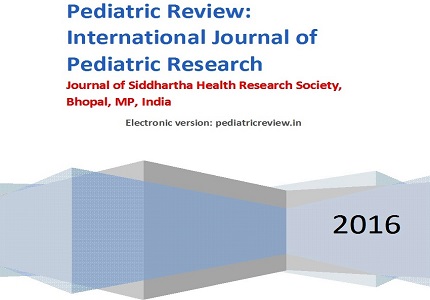Nutritional assessment of children infected with HIV on Pre-ART on ART
Abstract
Introduction: PEM is one of the commonest manifestations of HIV in India. Malnutrition has a major impact on the outcome of HIV as it not only increases mortality but also results in an impaired response to ART. Nutritional status of children in HIV may affect the outcome of patients taking ART, hence this study was planned. In India there are very less studies to compare various anthropometrical measurements in children on ART and without ART. In this study nutrition of children on ART was compared with those without ART.
Methods: All children who were confirmed HIV seropositive were included in this study. Nutritional assessment was done as per WHO classification and categorize as normal, stunting, wasting and under nutrition. Data was obtained and difference in proportion of wasting, stunting and underweight between ART and pre-ART group were analyzed by using SPSS software. It was Prospective case-control study. 1) Total 600 children below 12 years were registered in ART centre, out of which 125 pre-ART and 125 children on ART which came for follow up in ART OPD were enrolled in the study.
Results: Underweight was most common type of malnutrition in both group, prevalence of underweight and wasting were more common in ART group as compared to pre–ART group. No difference in prevalence of stunting in both groups.
Conclusion: There was statistically significant improvement in nutritional status (underweight and wasting) in ART group at the end of one year with no significant effect on stunting.
Downloads
References
2. Padmapriyadarsini, C., N. Pooranagangadevi, et al. Prevalence of underweight, stunting, and wasting among children infected with human immunodeficiency virus in South India. International journal of pediatrics 2009.2009:1-5. doi:10.1155/2009/837627.
3. World Health Organization Technical Report Series no. 477, November 1970, pg 9-18.
4. Gallo RC, Sahalludin SZ, Papovic M, Shearer G, Mark K, Barton F. Frequent Detection and Isolation of cytopathic Retrovirus from patient with AIDS and risk of AIDS. Science. 1984 May 4;224(4648):500-3.
5. Ira Shah, Nitin Shah, Mamta Manglani. IAP Speciality Series On Pediatric HIV: National Guideline Of Padiatric HIV. NACO and IAP 2006 Pg. 1-114.
6. HIV, Nutrition, and Food. A Practical Guide for Technical Staff and Clinicians: Family Health International 2007 Pg. 1-60.
7. Venter E, Gericke GJ, Bekker PJ, Gericke J, Bekker PJ. Nutritional status, quality of life and CD4 cell count of adults living with HIV/AIDS in the Ga-Rankuwa area (South Africa): Afr J Clin Nutr 2009;22(3):55-58.
8. Geert Tom Heiken. Case management of HIV – Infected severely malnourished childrens: Challenges in area of highest prevalence. Lancet 2008; 371:1305-07. Available on: www.thelancet.com.
9. SethA, Mehta S, Rajgopalan N, Dinkar C, Elango R, Samuel NM. HIV-associated anemia in children: A systematic review from a global perspective. Pediatrics 2009; 9:37-40.
10. Ikeogu MO, Wolf B, Mathe S. Pulmonary manifestations in HIV seropositivity and malnutrition in Zimbabwe. Arch Dis Child. 1997 Feb;76(2):124-8. [PubMed]
11. Addy Kekitiinwa, Kathrine J. Lee. Walker A. Albert M. Katja D. Initial growth, CD4, and viral load responses to HAART in Ugandan compare to UK/Irish HIV-infected children. J Aquire Immune Deffic syndrome, 2007; 49:384-94.
12. Lodha R, Upadhaya A, Vishal K, Kabra SK. Clinical Profile and Natural History of Children with HIV Infection. Indian J Pediatr 2006; 73(3):201-4. [PubMed]
13. Bachou H, Thorkild T, Robert D, James KT. Severe Malnutrition with and without HIV-1 infection in hospitalised children in Kampala, Uganda: Differences in clinical features, Haematological findings and CD4+ cell counts. Nutr J 2006; 5:27-32.
14. Ranbir Singh L. National guideline of Pediatric HIV. NACO and IAP 2006 Pg. 13-20.
15. Carolyn Bolton-Moore, Mwangelwa Mubiana-Mbewe, Ronal A, Cantrell. Clinical Outcomes and CD4 Cell Response in Children Receiving Antiretroviral Therapy at Primary Health Care Facilities in Zambia: JAMA. 2007; 298(16):1888-99.
16. Nayekwezi S. The use of anthropometric indices as an alternative guide to initiating antiretroviral threrapy in children at the midmay center. Uganda Stellenboch University 2008 Pg. 1-65.
17. Devi NP, Chandrasekaran K, Bhavani PK, Thiruvalluvan C, Swaminathan S. Persistence of stunting after highly active antiretroviral therapy in HIV-infected children in South India. Indian Pediatr. 2011 Apr;48(4):333-4.
18. Phillipa M, Patrick A, Danstan B, Michael M, Thorkid T, Mary F. . Growth, immune and viral responses in HIV infected African children receiving highly active antiretroviral therapy: a prospective cohort study. BMC Pediatrics 2010; 13:10-56.
19. Abebe M. Fessahaye A, Hematologic Abnormalities Among Children On HAART, In JIMMA University Specialised Hospital, Southwestern Ehiopia Hematologic Abnormalities Among Children on HAART 2007 Pg. 83-87.

Copyright (c) 2016 Author (s). Published by Siddharth Health Research and Social Welfare Society

This work is licensed under a Creative Commons Attribution 4.0 International License.


 OAI - Open Archives Initiative
OAI - Open Archives Initiative


